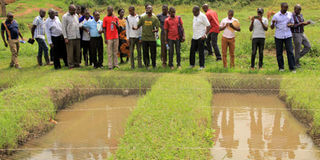How to keep predators away from your fish pond

Farmers taking lessons from an agronomist during a recent Seeds of Gold Farm Clinic at Kabanyolo. PHOTO/RACHEL MABALA
What you need to know:
Frogs eat fingerlings. To control them, clear their hiding places, which can be bushes around the pond. One can also install fish hiding places, which can be done by fixing wide drainage pipes at the bottom of the pond where fish can hide in case they sense danger.
Predators are among a fish farmer’s worst nightmare because one can lose his entire stock if they are not controlled.
These hunters include birds, snakes and frogs.
However, the aim of controlling them should not be to kill, as some of them are protected by law and have a role in the environment. Below, Seeds of Gold details how a farmer can control predators:
Birds
Fish predator birds include the blue heron, cranes, egrets and kingfishers. Studies show that total seasonal damage in fish ponds by wading birds is about 15 per cent of the projected production.
To control the birds, one can use decoys, scarecrows, nets, install fish hiding places, increase pond depth and use traps. Decoys are imitations of objects such as birds. Some birds like herons dislike competition, so if they pass over a pond and note that there is another bird; they are likely to move on.
Placing heron decoys at strategic sites around the pond is a control measure. To make the decoys look real, move them around the site regularly.
Scarecrows
Scarecrows and mechanical chasers of birds such as motion-sensing water jets can also help keep the birds at bay. Like decoys, move them frequently before the birds realise that they are fake.
A net covering the entire pond can also keep the birds away. In the absence of a net, criss-cross strings or wires over the pond.
Hiding places
One can also install fish hiding places, which can be done by fixing wide drainage pipes at the bottom of the pond where fish can hide in case they sense danger. Construction of the pond with a deep and shallow end is important as some birds don’t venture into deep waters and when threatened, the fish can escape to the deep end.
Feeding also predisposes fish to some birds such as cormorants that attack during feeding as fish tend to concentrate at the eating point.
Spending some time near the feeding point after the fish have eaten can offer some protection. Destroy the birds’ nests, especially if they are close to the pond can also help minimise the challenge.
Frogs and toads
Frogs eat fingerlings. To control them, clear their hiding places, which can be bushes around the pond.
Fencing off the pond also helps. One can also introduce frog-eating fish such as catfish and bass.
If one taps water from a river or other natural sources, install inlet and outlet screens to keep frogs at bay.
Draining and cleaning the pond regularly aids in reducing the frog population as they are manually removed during the exercise.
Snakes
Predatory snakes consume larva and fingerlings. Clearing bushes around the pond and fencing where possible will minimise the problem.
Insects and their larvae
These groups of predators prefer fish eggs and fingerlings. Introduction of fish that consumes insects is a control measure.
An oil emersion suffocates the insects and it can be applied to ponds with bottom feeder fish that might not also suffocate due to lack of oxygen.
Other fish
Catfish feeds on tilapia fingerlings, thus, careful selection of types of fish to introduce in a pond with more than one species is important.
Crocodiles, large lizards and turtles
The first two consume all types of pond fish while turtles prefer catfish. Clear bushes and fence the pond where possible. Trapping is also an option.
Otters
These are nocturnal and feed on fish at night. Their hiding places are holes under tree roots. Fence the pond and remove trees close to the pond.
Man
They can be hard to control but minimise risks by employing trusted workers, use of trained dogs, security guards, fence and lock the entry/exit points, install CCTV cameras, burglar alarms and electric fence.
Install hooks and other objects in the pond to prevent use of nets. Clear the bushes around the pond. Bushes act as hiding places for thieves especially the one that use hooks to fish.
Warning
Feeding your fish too often or offering them too much food can lead to several problems.
Both excessive digestive wastes and uneaten food can pollute the water and create high ammonia, nitrite and nitrate levels, and lower the oxygen level as well as lowering the pH levels.
If your water tests show high nitrate levels, it is very likely because you are overfeeding your fish. Further, excessive food floating in the water can clog filters, causing the water to become toxic.




